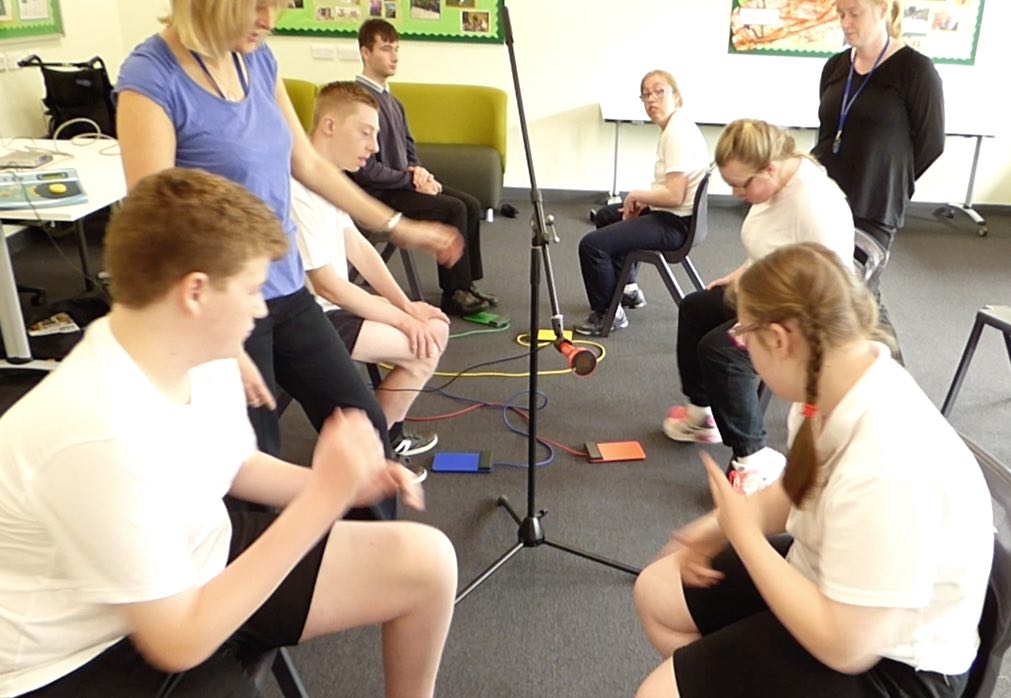Using accessible technology in classroom curriculum music making.
In this residential project, Soundbeam was used alongside traditional instruments to engage and motivate students with special educational needs and disabilities (SEND) to be more creative in their music making, increasing attention and concentration spans and nurturing working more collaboratively.

What is the context of the work?
Pear Tree School in Kirkham, Lancashire ( http://peartreeblogs.net ) is a school for pupils with severe or profound and multiple learning difficulties. Many pupils have additional difficulties and disabilities, including autism, sensory impairment and complex medical needs. About a fifth of all pupils are known to be eligible for free school meals. Most pupils are of White British heritage.
The work was led by Alex Hales, with support from Soundbeam, and involved up to 12 Key Stage 3, lower Secondary school aged students with a range of learning difficulties. The project extended over a three-day period. The school was looking at ways of incorporating more technology to complement and extend their curriculum music work.
What is the content of the work?
Music technology in SEND settings is often used for one-to-one sessions, or specialised composition/performance projects. This case study explores ways in which accessible technologies can be used to support a range of typical SEND classroom curriculum activities.
Students used Soundbeam to create new sounds, which they were able to use in a range of improvisation and composition activities. Graphic scores were used to structure and direct much of the composition and performance work.
In addition, the technology was used to support activities based on listening and responding to music. For example, students were responding to changes in pitch using hand movements and responding more freely to music, creating different moods.
Because the students found the technology and the sounds that they produced so engaging, staff noticed the tangible benefits in a range of areas. These included expressiveness, aesthetic sensitivity, originality and creativity, and improved attention/concentration spans. Using Soundbeam to make music together also improved their teamwork and co-operation skills.
What are the key features of the teaching and learning approach?
The teaching and learning approaches are essentially traditional, with an emphasis on truly integrating the use of technology into standard music classroom activities. Much of the work was leader-centred, yet students were given considerable freedom in choosing the sounds with which they wanted to work and how they might use those sounds in improvisation. The activities varied from some that were tightly prescribed, through to more open-ended exploratory music-making activity.
What are the key features of teacher/leader behaviour that are enabling those positive outcomes?
Activities from Soundbeams' Teaching Music with Soundbeam resource [Kindle books] series were chosen for this residency ( http://www.soundbeam.co.uk/teaching-music-with-soundbeam/ ). These are designed to provide a range of rich and relevant musical challenges for pupils to create, recreate, listen and respond musically. The chosen activities were selected to meet the requirements and aspirations of learners with a range of learning difficulties. The teachers worked as a team, taking responsibility for handling the technology, pacing the lessons and helping students to decide which musical activities were best suited for them.
What are the key features of context, content and activities that are enabling those positive outcomes?
The school has a well-established tradition of curriculum music making, led by a visiting specialist teacher. The school is well equipped, with good facilities and ICT support. The staff are keen to work in partnership with external providers and are always looking for ways in which to make their curriculum more engaging and inclusive. They are also aware of the developmental and social benefits that are additional outcomes from effective music-making activity. The Soundbeam hardware and accompanying teaching resources enable them to adapt musical activity, which is specifically tailored to their students making music together.
How replicable or adaptable is it?
This project is easily adaptable to provide suitable curriculum activity that can be integrated into music schemes of work. Essential resources include the Soundbeam technology package, plus the accompanying teaching resource Teaching Music with Soundbeam. For those who require it, training is available from Soundbeam, including CPD sessions and residential courses (see http://www.soundbeam.co.uk/training/ ).
